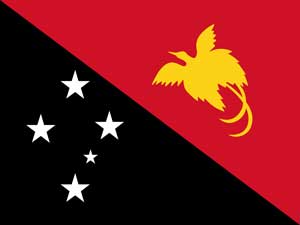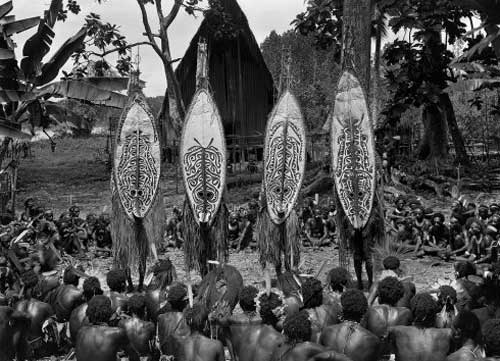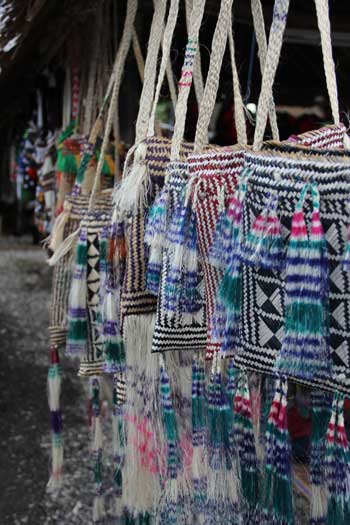POP Cultures: Papua New Guinea
Map
Flag

Quick facts
Official Name: Independent State of Papua New Guinea
Indigenous Peoples: Papuan Melanesian
Official Languages: English, Tok Pisin (Melanesian Pidgin), and Hiri Motu
Political Status: Independent Nation
Capital: Port Moresby
Population: 6,672,429 (2015 est.)
Greeting: “Hallo, gutpela monin” (Hello, good morning)
History and geography

In the heart of Melanesia is the nation of Papua New Guinea (PNG), which occupies the eastern half of the land mass New Guinea. PNG is located just 160 km (99 mi) north of Australia, and includes numerous outlying islands such as the islands of Manus, New Britain, New Ireland and Bougainville. The western half of New Guinea is Irian Jaya, a province of Indonesia.
The land area of PNG is about 452,860 sq km (174,849 sq mi) with a total area of 462, 840 sq km (178,703 sq mi)—about 1/10 the size of California—and mountainous. The two largest rivers are the Sepik and the Fly. PNG consists of four regions made up of 22 provinces, and has the largest area of intact rain forest outside of the Amazon in South America. The people of PNG are broadly ethnically Melanesian, but the nation is home to a huge number of diverse cultures and languages. Much of the land is still undeveloped and consists of sandy beaches and inland mountains called the Highlands. Although people have lived in the New Guinea Highlands for thousands of years, the mountainous interior has only recently been explored.
The Highlands region located towards the eastern part of PNG is divided into five zones and has elevations of over 13,000 feet. With fertile valleys the Highlands region is the most densely populated of PNG. The area is known for its cultural diversity, coffee plantations, orchids and numerous native animals and plants.
The Islands Region is comprised of the Bismarck Archipelago and the north Solomon Islands, which are the provinces of East New Britain, Manus, New Ireland, Bougainville and West New Britain. These tropical islands are home to the distinctive Lapita pottery culture (part of the Austronesian family of cultures) which has been studied extensively by archeologists and historians. Less densely populated than the Highlands region, only about 14% of the population live in the Islands Region.
The Momase Region is comprised of four provinces on the northern part of PNG. The area is characterized by tropical rain forests, cattle pasture lands and is known for producing coffee, cocoa, copra and sugar.
The southern part of PNG is called the Papua Region, and the capital of Port Moresby, located in the National Capital District, is the entryway for international travel into PNG. The region offers an array of activities and adventures for tourists, including museums, botanical gardens, markets and government buildings. The Central Province is noted for the beginnings of the Hiri, or the long-established trade voyages, of the Motu people which began in the early 1700s. The giant ocean-going double-hulled vessels known as Lakatoi, with their crab claw sails, were the main canoes used to trade with peoples from the Gulf province. The Gulf province is where the Turama, Kikori, Vailala and Purai Rivers flow. People live along the delta on houses piled high above the river banks. Until the arrival of Christianity, cannibalism and headhunting were part of the traditional practices of the people. The Milne Bay Province is where seven groups of islands, including the Trobiands, Woodlarks, Laughlans and D’Entrecasteaux Group, are found. The Papua region is also home to the Ballimo and Gogodala people, famous for their cultural beliefs, arts and giant long houses.
Lying just south of the equator in the western Pacific, PNG is believed to have been first populated over 50,000 years ago by people migrating from Southeast Asia and probably originating from Africa 50,000 to 70,000 years ago. The original inhabitants of island New Guinea were Papuan, Melanesian and Negrito tribes who spoke more than 700 different languages. The people of the mountainous New Guinea highlands independently developed agriculture around 7,000 BC, with a major migration of Austronesian speaking peoples arriving in the coastal regions about 2,500 years ago. These people, known as Lapita by archeologists, brought with them a sophisticated distinctive pottery, and introduced pigs and certain fishing techniques.
With a warm, humid tropical climate, each province experiences a rainy and dry season. The sweet potato was introduced about 300 years ago, transforming the traditional agriculture of PNG by supplanting taro, and subsequently increased the population in the highlands. In the past, cannibalism and headhunting were practiced in many parts of PNG, but these practices were stopped with missionization and colonial administrative pressure.
Spanish and Portuguese explorers first navigated the western part of New Guinea in the 16th century, but the Dutch took formal possession of West Papua (Irian Jaya) in 1828. In 1885, the northern coast of New Guinea was annexed by Germany and the British claimed part of the south. The British transferred their rights to this area to Australia, which became an independent nation in 1906. The former British New Guinea was renamed the Territory of Papua and New Guinea (PNG). Australia granted PNG limited autonomy in 1951, and in 1975, PNG gained independence.
In Bougainville, a secessionist movement took place for nine years. In 1989 guerrillas from the Bougainville Revolutionary Army shut down the Australian copper mine there and declared Bougainville’s independence. The Australian government set up a blockade until a peace treaty was signed in 1991.
During World War II, the Oro province in the central Papua region which had not only experienced the early Gold Rush days, was also the site of violent fighting between Allied and Japanese forces. An active volcano also killed thousands of people shortly after the war. The East Sepik province, first colonized by the Germans in 1885, also attracted laborers, mercenaries, traders, explorers, labor recruiters and missionaries. It was also the site where the Japanese surrendered in September 1945.
Today, PNG’s population is over 7,000,000, with over a third living in the Highland region. They speak over 800 local languages (with many minor dialects) but speak a pidgin language called Tok Pisin. Many people in PNG still live in small villages and make a living through agriculture, gardening and fishing. Land is owned by villages or communities, so visitors to PNG need to ask permission to enter.
Arts and culture

The people of PNG have a very vibrant and dynamic arts and culture scene, kept alive through elaborate rituals for life events such as death, feasts, marriages and initiations. Singing and dancing are often performed in elaborate traditional costumes called bilas.
Other artistic products of the Highlands region include traditional weapons, and Highlands’ hats, decorated with cuscus fur. The men traditionally wear a long beard and women wear brilliant scarves and brightly colored string bags called bilum, which carry everything from babies to firewood. Tribes are often distinguished by traditional headdresses with flowers and feathers, and body paint.
In the Papua region, one can find distinctive art styles, including masks, bullroarers, headrests, skull racks and gope boards–elliptical shaped and carved boards made to recognize acts of bravery or success. One can also find handcrafted pottery, jewelry and tapa cloth–a traditional cloth formed by beating the bark of the paper mulberry tree and decorated with various kinds of natural dyes.
Other artworks can be represented through cultural objects such as tall posts from the Sepik region that are used to decorate haus tambarans, or spirit houses, as well as ancestral boards and malangan masks which are intricately carved masks from New Ireland. The Maprik Area peoples are known for their forward leaning haus tambarans and Yam festival, featuring singsongs, rituals and woven fiber masks. People from Ambunti and the Middle Sepik are known for their polished carvings, spears and pottery.